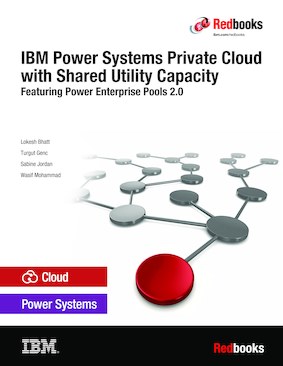
Published on 29 September 2021, updated 04 August 2022
Read in Google Books Order hardcopy
Share this page:
ISBN-10: 0738460044
ISBN-13: 9780738460048
IBM Form #: SG24-8478-01
Authors: Scott Vetter, Lokesh Bhatt, Turgut Genc, Sabine Jordan and Wasif Mohammad
Abstract
This IBM® Redbooks® publication is a guide to IBM Power Systems Private Cloud with Shared Utility Capacity featuring Power Enterprise Pools (PEP) 2.0.
This technology enables multiple servers in an to share base processor and memory resources and draw on pre-paid credits when the base is exceeded. Previously, the Shared Utility Capacity feature supported IBM Power E950 (9040-MR9) and IBM Power E980 (9080-M9S). The feature was extended in August 2020 to include the scale-out IBM Power servers that were announced on 14 July 2020, and it received dedicated processor support later in the year.
The IBM Power S922 (9009-22G), and IBM Power S924 (9009-42G) servers, which use the latest IBM POWER9™ processor-based technology and support the IBM AIX®, IBM i, and Linux operating systems (OSs), are now supported.
The previous scale-out models of Power S922 (9009-22A), and Power S924 (9009-42A) servers cannot be added to an enterprise pool.
With the availability of the IBM Power E1080 (9080-HEX) in September 2021, support for this system as part of a Shared Utility Pool has become available.
The goal of this book is to provide an overview of the solution’s environment and guidance for planning a deployment of it. The book also covers how to configure IBM Power Systems Private Cloud with Shared Utility Capacity. There are also chapters about migrating from PEP 1.0 to PEP 2.0 and various use cases.
This publication is for professionals who want to acquire a better understanding of IBM Power Systems Private Cloud, and Shared Utility Capacity. The intended audience includes:
- Clients
- Sales and marketing professionals
- Technical support professionals
- IBM Business Partners
This book expands the set of IBM Power documentation by providing a desktop reference that offers a detailed technical description of IBM Power Systems Private Cloud with Shared Utility Capacity.
Table of Contents
Chapter 1. Overview
Chapter 2. Planning
Chapter 3. Configuration and management
Chapter 4. Migrating Power Enterprise Pools from Version 1.0 to Version 2.0
Chapter 5. Use cases and sizing examples
Appendix A. Additional material